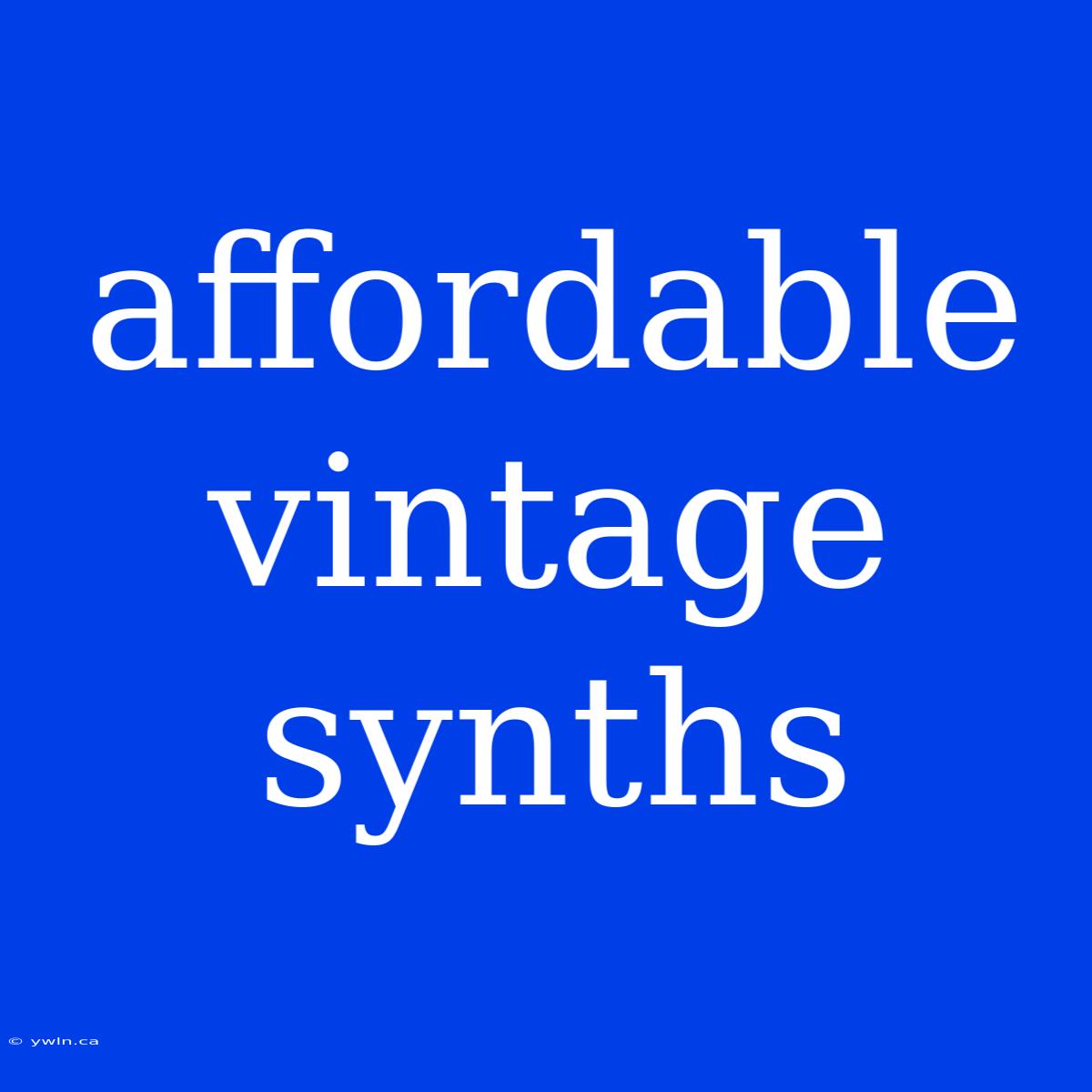Unlocking Vintage Synth Sounds Without Breaking the Bank: Affordable Vintage Synths for Every Producer
Have you ever craved the unique character of vintage synths but been daunted by their often hefty price tags? The truth is, you don't need to empty your bank account to access the rich sonic landscapes of yesteryear. The world of vintage synths boasts a treasure trove of affordable options waiting to be discovered.
Editor Note: This guide explores the exciting realm of affordable vintage synthesizers. It's the perfect resource for aspiring and seasoned producers seeking to expand their sonic palette without breaking the bank.
Analysis: We've delved into the vintage synth market, scouring online marketplaces, vintage shops, and forums to compile a comprehensive guide highlighting affordable models that offer incredible value for your money. This guide considers factors like sound quality, ease of use, availability, and price, making it a valuable resource for anyone seeking to incorporate vintage sounds into their productions.
Key Takeaways:
| Feature | Description |
|---|---|
| Price Range | Affordable vintage synths typically range from $100 to $1000, making them accessible to producers with varying budgets. |
| Sound Quality | Vintage synths offer a unique, analog sound that often cannot be replicated digitally, characterized by warmth, character, and imperfections. |
| Availability | Online marketplaces, vintage synth shops, and online forums offer a diverse selection of affordable vintage synths. |
| Ease of Use | Some vintage synths are easier to use than others. Consider your level of experience and the complexity of the interface when choosing. |
| Sound Design Capabilities | Vintage synths offer a diverse range of sound design capabilities, ranging from classic monophonic synths to polyphonic beasts packed with unique features. |
Exploring the World of Affordable Vintage Synths
The Roland Juno-106: This iconic 6-voice polyphonic synth is a favorite among producers for its warm, lush pads, versatile soundscapes, and iconic "Juno chorus." The Juno-106 remains surprisingly affordable, offering an excellent entry point into the world of vintage synths.
The Yamaha DX7: This digital FM synth redefined the sound of the 1980s. Its unique sound design capabilities allow for creating everything from bright, cutting leads to complex, evolving textures. While some might find its interface daunting, the DX7's sonic potential is undeniable.
The Casio CZ-101: This digital synth, known for its unique Phase Distortion synthesis, is a cult favorite. Its affordability, portability, and intriguing sound make it an excellent choice for experimental music and electronic producers.
The Korg Poly-800: This 8-voice polyphonic synth boasts a classic analog sound with a rich, warm tone. Its affordable price and user-friendly interface make it a great option for beginners and seasoned producers alike.
The Moog Prodigy: This iconic monophonic synth is known for its thick, raw sound, perfect for basslines, leads, and experimental soundscapes. The Prodigy's affordability makes it a valuable tool for anyone seeking to add a classic analog touch to their music.
Unveiling the Secrets of Vintage Synth Sounds
1. Analog vs. Digital:
- Analog: Characterized by a warm, organic sound with subtle imperfections and nuances.
- Digital: Offers precise control and a wide range of possibilities, but may lack the warmth and character of analog.
2. Monophonic vs. Polyphonic:
- Monophonic: Can only play one note at a time, ideal for leads, basslines, and experimental soundscapes.
- Polyphonic: Can play multiple notes simultaneously, perfect for pads, chords, and melodic compositions.
3. Synthesis Techniques:
- Subtractive Synthesis: Starts with a complex waveform and subtracts frequencies through filters and other effects.
- Additive Synthesis: Builds sounds by combining multiple waveforms.
- FM Synthesis: Uses frequency modulation to create complex and evolving textures.
- Phase Distortion: Uses phase distortion to create unique and unusual sounds.
Beyond the Basics: Tips for Acquiring and Using Affordable Vintage Synths
1. Research: Explore online resources, forums, and vintage synth communities to learn about different models, their strengths, and potential issues.
2. Patience: Find a good deal on a vintage synth may require patience and perseverance.
3. Condition Matters: Ensure the synth is in good working condition before purchasing.
4. Modern Upgrades: Consider upgrading the synth's power supply or adding MIDI capabilities for easier integration with modern gear.
5. Explore Patches: Experiment with different patch settings to discover the synth's sonic potential.
6. Experiment and Have Fun: Don't be afraid to try new things and explore the unique sounds your vintage synth offers.
The Takeaway:
Affordable vintage synths offer a unique sonic palette that can breathe life into your productions. By exploring the diverse selection of models, understanding their characteristics, and approaching them with an open mind, you can unlock the power of vintage synth sounds without breaking the bank. The journey begins with finding the right synth for your needs, so get out there and start exploring!

